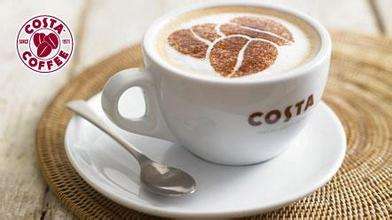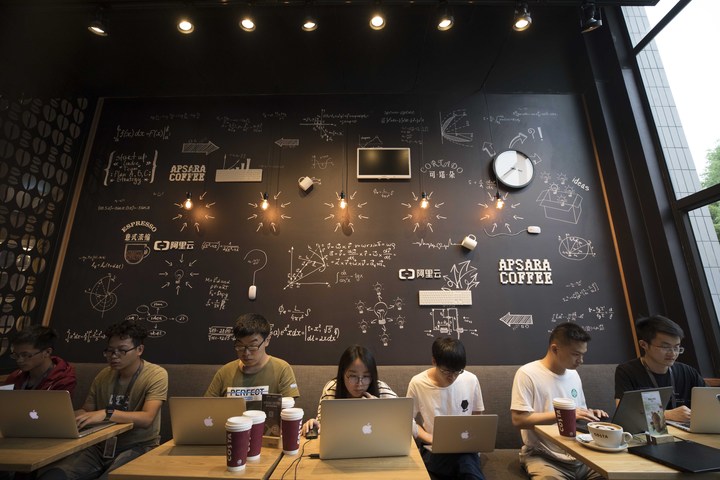Costa Coffee: Late birds don't eat insects?
For professional baristas, please follow the coffee workshop (Wechat official account cafe_style)

Self-media "Ka Men" and "Meituan Dianping Research Institute", which specialize in coffee and tea industry, recently released the first issue of beverage industry data report, which showed that the number of cafes in China exceeded 100000 in 2016. Fierce competition, increased shuffling speed, easy to open a shop and difficult to make money have become the common feelings of coffee shop owners.
If you ask Chinese consumers what they think is the typical brand of the cafe, there is no doubt-Starbucks, few people will think of the red figure that has been quietly chasing behind the green Starbucks, Costa Coffee.
In 1971, the Lambeth,Costa brothers Bruno and Sergio founded their famous coffee bean roaster in London, slowly processing traditional Italian roasting to produce exciting coffee for local restaurants and espresso franchises. People loved this kind of coffee so much that in 1978, the first Costa espresso bar was announced in Vauxhall Bridge Road, London.
Since then, the Costa coffee store has expanded at the growth rate of opening two new stores a year. In the 1990s, Costa developed rapidly. In the UK, Costa surpassed Starbucks in 2010 to become the largest coffee shop and the largest chain store in the UK. Today, Costa has more than 2000 stores in the UK, covering airports, shopping malls, hotels and office buildings.
In December 2006, Costa opened its first Chinese store on East Nanjing Road in Shanghai, which is also the brand's first store in the Asia-Pacific region. At this time, its competitor, Starbucks, which has been ploughing the Chinese market for many years, already has more than 300 stores (direct stores + authorized stores) in China.
There is no light in yoga. Just as KFC is to McDonald's and Pepsi is to Coca-Cola, on the streets of many cities in China, you will see a Costa near Starbucks or some popular shopping malls, and there is a very low name "Kashijia".
Until now, although Costa's development in China has been under the banner of strong expansion, in fact, its expansion rate still can not catch up with Starbucks. As of March 13, 2017, Costa had 244 stores in mainland China, according to its website. By the end of 2016, Starbucks had more than 2400 stores in mainland China.
In today's Chinese market, Starbucks is not the only competitor to Costa.
At present, Starbucks ranks first in the number of coffee chain stores in China, followed by Pacific Coffee under China Resources. As of December 2016, the number of Pacific Coffee stores worldwide has reached nearly 500, including more than 300 in Chinese mainland region. The number of stores far exceeds that of Costa.
Pacific Coffee, in the eyes of consumers as a "low-key and introverted" brand, seems to take advantage of the fierce struggle between Starbucks and Costa, quietly found a position for itself, and successfully counterattacked.
Yin Jie, an expert on brand research, said that Costa has been in China for 10 years, and it has kept a low profile for 10 years. The goal of opening stores is also shrinking, from "opening 2500 stores in 2018" to "opening to 900stores by 2020". Today, Costa, which has experienced a lot of blows, has to redefine its brand value and think about its future.
As a brand from the United States, Starbucks' development strategy is to capture the big cities first, create a good reputation, and then take it as the center to march into the smaller cities around it. Starbucks' ultimate goal is to open tens of thousands of stores around the world to achieve ubiquity like McDonald's.
Costa is a brand from the UK, and the internationalization of the brand began in the late 1990s. From Costa, people can feel the common shortcomings or "characteristics" of British companies-take their time and be a pacing gentleman at all times. When Costa opened its first store in China, Starbucks had been working in Greater China for 10 years and carved its name into the almost blank consciousness of Chinese consumers, becoming synonymous with coffee (beverage).
The theory of "preconception", or simply common sense, is reflected in the brand competition of Chinese coffee shops. Today, almost no one knows Starbucks among young consumers in large and small cities in China, while Costa is well-known only in first-tier cities.
However, Yin Jie believes that "preconception" is not irreversible. Ice cream brand Haagen-Dazs, an unknown local brand, has a shorter history than Maadiel in northeast China and has not been in China for too long, but it has successfully counterattacked its strong preconceived rival and Lu Xue. Suddenly it has become the first high-end brand in China's ice cream market.
Yin Jie said that preconceived, in fact, means to seize the opportunity of brand creation or entry. Preconceived, as long as seriously manage a good brand image, almost all can become synonymous with categories.
Important Notice :
前街咖啡 FrontStreet Coffee has moved to new addredd:
FrontStreet Coffee Address: 315,Donghua East Road,GuangZhou
Tel:020 38364473
- Prev

In Yunqi town, this cafe is full of engineers and a magical blackboard.
I drink a lot of coffee, but have you ever seen coffee that knows the code? On May 11, the country's first engineer-themed coffee shop officially opened in the Ali office district of Yunqi town in Hangzhou, and COSTA joined hands with Ali to build this Code Space coffee brand. According to Jin Jia, director of the project, the purpose of creating such a themed coffee shop for programmers is to create a free coffee shop for them.
- Next

Where did all the little sisters who worked in the coffee shop go?
Professional barista communication, please follow the coffee workshop (Wechat official account cafe_style) little sister ah! The old man thought of you and remembered that there were more than a dozen female clerks in coffee shops who had a little chat in recent years, and every new clerk in the frequent shops would be warned about the old man's coffee preference and remind him that he was good at flirting with the salesgirl. According to the statistics, they spent a lot of money after they left.
Related
- What documents do you need to go through to open a coffee shop? coffee shop coffee shop certificate processing process
- How to purchase Coffee beans in small Cafe how to choose a suitable supplier for domestic Coffee supply Company
- How to drink Starbucks Fragrance White Coffee? how to make Australian White Coffee? what Italian coffee beans are recommended?
- The Story of Flora Coffee: the name of Flora Coffee Bean and the implication of the Flowers on Florna Coffee
- How much does a cup of coffee cost? How much is the profit of a cup of coffee? What is the profit of the coffee shop in a year?
- Yunnan small Coffee, known as "fragrant Coffee", introduces the characteristics of Alpine Arabica Coffee producing areas in Yunnan, China
- 2023 latest Starbucks full menu price list how much is a cup of Starbucks coffee what is better to drink the most popular hot and cold drinks recommended
- Starbucks different kinds of Coffee Price list Starbucks menu 2023 Top Ten Best drinks in Starbucks
- Starbucks Spring praise Comprehensive matching Coffee Bean theme Story Packaging implication and taste description
- The cost of a cup of coffee latte American coffee cost price and selling price

